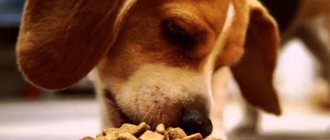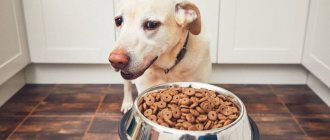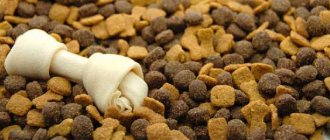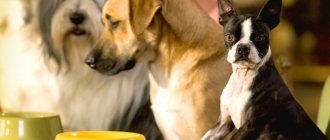How to feed a dog correctly?
At the stage of purchasing a purebred animal, you need to think about what to feed the dog.
Read about the characteristics of the breed, consult with experienced dog lovers, and do not hesitate to ask the breeder from whom you are planning to purchase a puppy. The basic principles of nutrition remain the same for all dogs, regardless of breed, size, coat length and color.
How many times a day should you feed your dog?
The younger the animal, the more often it needs to be fed. This is due to the small size of the stomachs and limited ability to digest food.
Industrial feed
By purchasing ready-made food, you save a lot of your time, because you don’t have to choose food, prepare a diet, cook, stew and bake dishes.
When deciding what food to feed your dog, consult the breeder. Select finished products taking into account breed characteristics. There are special foods on the market for small and large breeds.
Ready-made food is divided into two large groups: dry and wet food. Dry food is the most popular due to its convenience. They contain 7-10% water, while wet ones contain from 30 to 60%.
All feeds differ in quality and price.
- Economy class. It is attractive due to its low price, but long-term use by animals leads to disastrous results - illnesses and early death. Such products are based on raw meat from poor quality by-products, cheap grain and soy. Manufacturers often use synthetic flavors and taste enhancers, which are addictive in dogs. Most of the widely advertised foods are economy class: Pedigree, Chappi.
- Premium class. When wondering whether it is possible to feed a dog dry food, many people worry about its benefits. Use premium products, which include high-quality offal, natural meat (25-30%), rice. Most dog owners prefer this particular class: Royal Canin, Pro Plan food.
- Super premium. Contains a much larger percentage of meat (over a quarter), as well as high-quality offal - heart, liver. This food is suitable even for puppies. Manufacturers do not use flavorings or flavor enhancers. However, such food costs an order of magnitude higher and is not available to everyone. The most popular foods: Eukanuba, 1st Choice.
- Holistics. The ideal solution to the question of how to feed your dog correctly is to buy high-quality food from the holistic class. They contain a lot of natural meat, vegetables, berries and fruits. The most popular brands: Acana, Now Fresh, Grandorf.
An additional advantage of using commercial dog food is that there is no need to give vitamins. Everything you need is already included in high-quality food.
Natural products
If you prefer to cook for your pet yourself, then you need to know which products are preferable for a balanced, healthy and safe menu.
Feeding a dog natural food should not include the following products: pork, milk, allergenic fruits, semolina and corn grits, onions, garlic, cabbage.
Choose quality food for your dog.
- Meat. Meat products should make up at least 25% of the daily diet. It is preferable to use low-fat varieties: beef, veal, turkey, rabbit. Feed chicken with caution.
- Offal. Despite the fact that many consider bones the best dog treat, it is worth giving preference to high-quality offal: heart, liver.
- Fish. Give us boiled sea fish.
- Cereals. Use healthy grains to make porridge. Buckwheat and rice are considered the best.
- Vegetables. Excellent sources of vitamins: carrots, beets, peppers, tomatoes, parsley, dill.
- Fruits. In order to diversify your diet, include apples, pears, and berries.
- Dairy products. Milk causes bloating, but fermented milk products are very healthy. Make sure that their fat content is no higher than 5%.
Having decided on how to properly feed your dog in favor of natural products, do not forget to periodically give your pet a complex of vitamins and minerals.
About proper feeding of a dog: myths and reality
PHOTO SHUTTERSTOCK
We live in incredibly interesting times.
With the advent of ready-made food more than 25 years ago in the still unexplored food diversity of the CIS, the world of dog breeders in our country was divided into two irreconcilable camps.
Let's call them “naturalists” and “feeders”.
Debates about food and natural food buzzed within the walls of kennel clubs, in the trampled meadows of training grounds, remaining alien to the common man. But very soon the Internet burst into our lives...
As befits the spirit of the times, everything that gives birth to someone’s inquisitive mind, burdened with a lot of free time, then pours out in an uncontrollable stream into the vastness of the virtual world.
It’s good if an experienced breeder, athlete or instructor (people with specialized education) found the time and energy to share their experience, but another option is possible.
As soon as a person buys a puppy and looks at some forum in search of answers to questions, an avalanche of forum consciousness immediately falls on his tremulous psyche, and here one can only feel sorry for the poor thing.
The millstones of mass media disinformation under the motto “we want the best for him” successfully grind the consciousness, instilling in the owners a feeling of guilt that “he is doing everything wrong.” As a result, such “good” advice and myths about feeding can even harm animals.
| The methods of feeding dogs are based on the developments of zoo nutritionists, and individual feeding is carried out directly by the owners, depending on the characteristics of the breed. PHOTO BY MARINA KOVAN |
MYTH 1. All dogs have a common ancestor - the wolf, which means they should be fed food that is as close as possible to the diet of the wolf.
Domestic dog (lat. Canis lupus familiaris): class mammals, order carnivores, family canines, genus wolves, species wolf, subspecies dog.
Wolf, or gray wolf, or common wolf (lat. Canis lupus), class mammals, order Carnivores, family Canidae, genus wolves, species wolf.
When I hear from another owner, for example a Chihuahua weighing 2.5 kg, that he read that his Musechka’s ancestors were wolves, and he really wants to feed his dog a diet as close as possible to the diet of a wild animal (only raw offal, meat , bones, vegetables. and no carbohydrates, because wolves don’t eat porridge), I really want to ask: where does so much romanticism come from in wolf skin? Why, when we buy a dog, do we refuse to see it for what it is - a dog?
Studies of mitochondrial DNA (mtDNA) in dogs have pointed to a common ancestor with the wolf that may have existed more than 100,000 years ago. Numerous published works indicate that a genetic split in wild ancestors occurred more than 30,000 years ago, allowing dogs to become a separate subspecies.
In addition, on different continents and even in different climatic zones, the ancestors of local aboriginal dogs may be different. The change that occurred in the dog's genome became decisive in the future fate of the species.
This is extremely important, since one of the most significant evolutionary changes in dogs, in addition to differences in the genome, phenotype (appearance), behavioral characteristics and much more, is the physiological change in the digestive system.
One of the key adaptive changes that we need to talk about is the high (relative to existing wild wolves) ability of dogs to metabolize carbohydrates.
Physiological changes in the digestive system, established over centuries of existence next to humans, have in our time played a key role in the development of veterinary medicine and the science of feeding - veterinary dietetics.
| There is only one way to find out how attractive your dog's food will be: by feeding it. PHOTO PIXABAY |
MYTH 2. There is no need to add any additives to meat diets, since meat contains everything you need.
The diet of a wild animal, which I wrote about just above, is, of course, possible and widely used. Meat and offal are excellent sources of protein, essential and essential amino acids; vegetables and fruits, berries are sources of fiber, oils are important for energy and enriching the diet with fatty acids.
Bones can serve as a source of calcium when given in certain amounts in the diet. It would seem that everything is fine... Here it is, real “wolf food”! However, when analyzing such diets, I see the same mistake every time: 99% of them are not balanced.
Those. The amount of nutrients and energy a dog (and especially a growing puppy) needs is either insufficient or excessive, or these substances are in incorrect proportions.
Feeding only “dietary meat” (chicken breast, veal, beef tenderloin) is especially dangerous. If mineral deficiency is not so critical in diets containing bone tissue, then feeding only veal or chicken breast can be fatal.
A deficiency of vitamins, minerals, fiber and fatty acids with such feeding can lead to serious diseases. For example, calcium deficiency.
The most common situation: owners with the best intentions feed the puppy chicken breast, “giving him all the best.” And then one day the baby awkwardly stumbles or jumps from the sofa, from his hands and... breaks a paw or two at once.
The frightened owners rush to the clinic, where an attentive doctor takes an x-ray and makes a diagnosis: nutritional hyperparathyroidism. Sounds scary. The point is simple. Calcium is one of the basic macroelements stored in bone tissue. Calcium ions are vital for the correct transmission of nerve impulses and even for ensuring the correct rhythm of the heart.
| The diet of a hunting dog during the working season differs from that of a domestic dog, which does not spend as much energy searching for game. PHOTO SHUTTERSTOCK |
Nature is wise and amazing. If there is a deficiency of any vital substance, the body uses any means to maintain their required concentration in the blood serum (it is from this that calcium ions enter the target organs).
If calcium is not supplied from food, it will be removed from the bones. This whole process is regulated quite complexly through the hormones of the thyroid and parathyroid glands. With a lack of calcium, the work of these glands is “redirected,” which leads to the leaching of calcium from the bones and its transportation to vital centers.
Bone density decreases so much that it cannot even support the puppy’s own weight. The good news is that nutritional hyperparathyroidism is treatable. The question is, why bring it to him?
To be fair, it must be said that deficiencies and excesses of many nutrients accumulate for a long time and may not appear at all throughout the dog’s life. But we want to talk about what is right and what happens, and not about possible experiments on your dog.
MYTH 3. Feeding natural food is cheaper than feeding food.
As I wrote above, a balanced diet contains not only meat of various types, offal, cereals, vegetables and oils. In addition, supplements of minerals and vitamins are necessary.
Unfortunately, there are currently no professional supplements on the Russian market that would combine all the essentials, and our task would only be to determine the required quantity.
At least two or three additives, depending on the task at hand, are now used when preparing even the simplest diet. In any case, a well-formulated “natural” food from high-quality ingredients that satisfies the dog’s needs for vital nutrients can be equal in price to premium, and sometimes super-premium food with a good composition.
MYTH 4. All industrially produced food is poison and dogs die from it. From the point of view of common sense, the very idea of such a “conspiracy” among feed manufacturers is at least absurd.
If we follow this theory and take into account the dynamics of the development of the pet industry in the world over the past 50–60 years, the number of dogs in all developed countries where owners use food should have either decreased to critical levels or disappeared as a species altogether. If the consumer disappears, the producer goes bankrupt.
| What is good for a wild wolf can be harmful to your domestic Tobik. PHOTO SHUTTERSTOCK |
Lack of information gives rise to myths. How many of you know how dry or canned food is produced? How many of you visited the production? In conditions of fierce competition, conscientious manufacturers allow themselves to lift the veil of secrecy about the creation of their product.
Remember, above we talked about changes and consolidation at the genetic level of the dog’s digestive system, in contrast to the wolf? It was these changes that prompted specialists to begin building research institutes, bases and laboratories for the study of dog feeding.
You can talk as much as you like about the ingredients, the benefits or harms of certain components indicated by the manufacturer on the packaging. You can compare and argue that some foods are “definitely ideal” (here it is customary to remember the wolf), while others are poison, but you can’t argue with the facts.
As a veterinarian, I have the opportunity to observe changes in the feeding of dogs for a period of time sufficient to voice conclusions.
If just about 15 years ago, almost every shift in a veterinary clinic began or ended with a patient with acute dilation or volvulus of the stomach, even in a not very large dog (for example, an Irish setter), subsequent emergency surgery and washing out of the stomachs of porridge and other fermented components of “natural”, then in the last decade such patients have almost never been encountered.
The life expectancy of dogs, even large breeds, has increased significantly. Thus, the bloodhound, one of the breeds most predisposed (after the Great Dane) to acute dilatation of the stomach, comes into the clinic only for the next vaccination.
| Ekaterina Vladimirovna Smolitskaya is a veterinary nutritionist. Total experience working with animals is more than 20 years. In general, she has been in veterinary medicine for more than 13 years. Favorite specialties: intensive care, anesthesiology, veterinary nutrition. Photo by the author. |
The key advantage of industrially produced feed is that these diets (we are talking about conscientious producers) are balanced. If in the case of a “natural” dog, the owner needs to contact a veterinary nutritionist to put the dog’s nutrition in order, then the food does not require such an approach.
A little higher I wrote about nutritional hyperparathyroidism. So, when using feed, I have never encountered this disease.
MYTH 5. Food is made from dogs and dead cattle killed on the roads.
Can you imagine feed factory workers wandering thoughtfully along the roadsides in the early morning, looking for downed dogs and crows?
The capacity of large factories is such that I’m even afraid to imagine what kind of catastrophe would have to happen in order to provide at least one enterprise with such a strange and very dubious raw material base.
The quality control of raw materials entering factories for the production of animal feed could be the envy of more than one food industry.
| Meat, it would seem, is such an understandable product in a dog’s bowl, but the number of myths about it never ceases to amaze. PHOTO BY EKATERINA SIDOROVA |
MYTH 6. Food is evil: all modern dogs can no longer digest meat.
The evolution of the dog, like ours, does not stand still. Selection, adaptation to environmental conditions - all this is a huge layer of factors that influence any living system.
Nutrigenomics is a science that studies the effects of nutrients on a living organism and their relationship with the occurrence of diseases. To date, there are very few studies confirming the connection of any component of food with the occurrence of diseases in dogs, and so far they cannot be considered reliable.
Some breeders fundamentally adhere to natural feeding, while at the same time a huge number of nurseries use ready-made food. Could this, over several generations of dogs, affect their ability to "digest raw meat"? Quite possible. Is it good or bad?
This question is of purely scientific interest. In my practice, I see a variety of dogs and a variety of owners. Some people like pictures of beautifully arranged food in dog bowls, and they decide to feed them the same way.
Someone, on the contrary, says: “I don’t have time to fuss with meat, pick up some food for us.” In both cases, the final decision, oddly enough, is made not by the owner, but by the dog. Only by assessing her reaction to food can we understand whether the feeding tactics we have chosen are suitable for the pet or not.
There is no other way to know what is bad and what is good for each dog.
You can endlessly criticize everything and everyone: instructors (they advised us!), breeders (they bred here, but the dogs don’t tolerate meat!), veterinarians (they sold out to food manufacturers!)…
Just one small question for you, dear owners: why, when buying a puppy, kissing him on the nose and pulling behind the ear, do you forget that he is alive? Why are you so persistently looking for the “On” button, when clicked it will exactly meet your expectations and preferences, formed on the basis of beautiful pictures on the Internet?
What should I feed him - Benya, Lucky or Tsvetochka? Something that suits only them...
Ekaterina Smolitskaya October 13, 2022 at 09:50
Diet during pregnancy
The diet for dogs carrying puppies should be rich in nutrients. Give preference to high-quality feed, and also give a complex of vitamins.
You should not radically change food during pregnancy. Increase the portion weekly from the second trimester by no more than 10%.
The saturation of nutrients must be sufficient to meet the needs of not only the mother’s body, but also the fetus. Pay special attention to proteins, fats, and minerals. You should not overfeed the animal, as obesity interferes with normal childbirth.
How to teach your puppy to sleep through the night?
Taking home a puppy is akin to bringing a newborn baby home from the hospital. He has yet to be taught literally everything in order to be introduced into our big and sometimes cruel world. The puppy does not know where the toilet is in your house, he does not know how to obey your orders. And, as with a nursing baby, your and your pet's sleep schedules can vary greatly. How to make your puppy learn to sleep peacefully throughout the night?
What to feed a nursing dog?
The diet of a nursing bitch is very important, because it affects not only her health, but also the full development of the puppies. The serving volume should be only one and a half times larger than usual, but the concentration of nutrients in it should be an order of magnitude higher.
What to feed a nursing dog so that the puppies have enough vitamins?
- Percentage of natural products . 45% of the daily food intake should be meat, offal or fish. 30% is cereals (rice, oatmeal, buckwheat). 15% vegetables and 10% dairy products will complete the daily diet. Use only high quality products.
- Industrial feed . If the dog is accustomed to dry food, switch it to holistic or super premium food. The high cost is compensated by the absence of health problems and savings on veterinarian visits.
- Drinking regime. Carefully monitor how much water your dog drinks. If she refuses to drink, put a sugar cube in the water.
- Complex of vitamins . Consult your veterinarian to help you choose the appropriate vitamin supplement.
What to feed a nursing dog to make it produce more milk? Follow the drinking regime, and also increase the calorie intake - and your bitch will produce a sufficient amount of milk.
How to calculate the volume of food?
For adults, the rate of consumption of natural food is 3-4% of weight. Accordingly, we calculate as follows: for a 15-kilogram dog, 15x0.04 = 0.6 kg or 600 grams of food will be required (0.04 is a coefficient indicating the percentage of body weight divided by 100%). 2/3 of the diet is meat and dairy products and 1/3 is cereals and vegetables. For aging individuals, the amount is reduced to 2.5-3% of the mass; puppies are given more - up to 6%.
As for food, large individuals (30-65 kilograms) need 400-600 grams of premium dry food per day. Medium breeds (15-30 kilograms) – 300-400 grams. Representatives of small breeds (up to 15 kilograms) – 150-300 grams. If the dog participates in sporting competitions or hunting, then more food can be given.
Feeding the puppies
For puppies, the best food is mother's milk. It is very important that everyone gets their first colostrum, which contains unique antibodies. The feeding frequency is at least 5-6 times a day; from the age of three months, reduce the feedings to 4. It is advisable to always feed the puppies at the same time.
The diet must have a high protein content - twice as much as that of an adult animal.
Use special food, and add egg whites and meat to the dogs’ natural food.
How to train a puppy to sleep at night?
The most basic and initial things include the responsibility to teach the puppy to sleep at night , or at least teach him not to disturb the owner when he sleeps. However, teaching a puppy to fall asleep on time is quite difficult; in this respect, puppies are like babies. Very often, instead of sleeping, the puppy prefers to be awake and play. Let's figure out what is needed in order to teach a puppy to sleep at night .
— At what age is it better to buy puppies? It is best to purchase a puppy when it is at least eight weeks old. It is during this period that it is easiest to accustom him to sleep at night . By purchasing a puppy at the age of twelve months, you can be sure that you will not have any special difficulties in the matter of sleep at night. However, even at twelve weeks, puppies are not always calm at night. But this is more often caused by stress, which is provoked by separation from the mother and a sharp change in the situation.
Problem situations
An improper diet affects your dog's health. Let's look at the most common problems that may arise.
To establish an accurate diagnosis, consultation with a veterinarian is necessary!
Dog poisoning
Here is a list of symptoms that may indicate poisoning:
- pain;
- moans;
- rapid or difficult breathing;
- vomit;
- diarrhea (sometimes with blood);
- convulsions;
- weakness.
If you have a food allergy, it is better to give activated charcoal or a weak solution of potassium permanganate before the doctor arrives. If your dog is poisoned by non-food substances, do not self-medicate, because even potassium permanganate can cause harm.
Before visiting the veterinary clinic, analyze the dog’s behavior and what it has eaten recently.
Digestive problems
Bloating and volvulus can occur in an animal, regardless of its breed. Following the recommendations of veterinarians will allow you to properly care for your pet’s health.
- Should you feed your dog before or after a walk? You should not go for a walk immediately after eating. Wait 3-4 hours or walk on an empty stomach.
- How many meals should there be? An adult dog only needs to eat once. Set aside a specific time and stick to the routine.
- What foods can cause bloating? If you feed your dog natural products, exclude cabbage, legumes, and milk. If you are feeding commercial food, try changing the brand or switching to a higher quality food.
The dog refuses to eat
Even if you have properly organized the feeding and walking regime, a problem with loss of appetite may arise.
To determine the true reason for refusing to eat, contact your veterinarian. Self-medication can lead to complications or death of the animal!
- Psychological atmosphere. Analyze the dog’s behavior, which could cause a sudden change in mood: change of environment, stress.
- Damage to the oral cavity. It is not uncommon for a dog to refuse to eat if its gums, tongue or tooth are damaged. Examine the mouth for wounds.
- Changing food or bowl. Perhaps your dog does not accept the new food or does not like some product.
- Disease. If the animal looks weak or lethargic, it is necessary to urgently contact a veterinary clinic, since loss of appetite often becomes a symptom of various diseases.
Following simple rules will help you organize proper care for your beloved dog and protect it from disease.
Basic walking rules
A four-legged friend is a very active animal that urgently needs regular physical activity. The duration and number of trips to the yard completely depends on the individual characteristics of the pet, its age and breed.
Formation of the regime
It is necessary to build a feeding and walking regime for the dog based on the owner’s daily routine. But, once you have accustomed your pet to it, you should not break it. Any deviations disrupt the pet’s internal routine and deprive it of confidence in later life. Constant violations lead to negative consequences for physical and emotional well-being.
Many owners set aside time to visit special sites in the morning - before work or school - and in the evening. On weekends, the duration and number of walks in the fresh air can and should be increased.
The puppy has to be taken out more often. This is necessary to teach you to empty your bowels outside the home. Such exits from the house should not be delayed: it is optimal to devote no more than 15-30 minutes to them. Gradually the number of exits is reduced, bringing it to 2 times a day. Veterinarians and experienced owners recommend the following daily routine:
- Early morning - walk for 30-60 minutes. At this time, the animal gets rid of what it managed to digest and accumulate during the night.
- After leaving in the morning, feeding (with two meals a day).
- Mid-day - a short trip outside. In 15-20 minutes the pet will have time to empty its bladder.
- Evening – an active and long trip to a special area with elements of games and training.
- After the evening promenade - feeding.
It is advisable to spend time with your pet in the fresh air in the morning and evening hours. The first promenade should be short and last from 30 minutes to 1 hour. The second one is longer, so that the dog can throw out all the accumulated energy.
During the evening walk, the pet must have time to:
- empty your bowels and bladder;
- communicate with relatives on the site;
- run around, sniff everything around;
- follow the owner's commands, play with him.
Compliance with all these points makes the walk successful. The pet will be able to fully understand the world around it, establish contact with humans and other dogs. As a result, the dog will receive positive emotions and get rid of excess energy.
Walking followed by feeding will help maintain the good health of your four-legged friend. The owner’s task is not to miss visiting the street. The pet is not able to endure for a long time and can go to the toilet right in the house or apartment.
To prevent unpleasant consequences, in addition to the main two exits, it is advisable to add 2-3 more exits to the yard for 10-15 minutes during the day.
Why shouldn't you give bones to your dog?
Many dogs eat bones, but that doesn't make them any less dangerous. The dog chews the bone into thousands, thousands of small sharp fragments! They all end up in the stomach. Something is digested, the rest is compressed and goes through the intestines, turning into a huge prickly hedgehog, with sharp debris sticking out in all directions. This is the main danger. It is a rare dog that spits out fragments when it chews something; usually everything is swallowed with excitement. Unless you are prepared to keep an eye on every bit of bone you chew, it is best not to give your dogs bones at all.
No need to whine!
During the first week of your puppy being at home, he may start crying or whining pitifully before going to bed. This happens because the baby has a hard time being separated from the family and is used to sleeping with his mother and brothers and sisters. The main advice: do not get along with your pet, do not try to replace his mother: you risk teaching a dangerous pattern of behavior into a small puppy for life.
If your puppy cries or whines, leave him alone anyway. Allow a reasonable amount of time, long enough for him to calm down without your help. If crying continues for a long time, give the command “No” and do not condone such behavior under any circumstances. Try to somehow distract his attention, stay nearby, but do not cajole the puppy: otherwise he will remember that only crying and whining can achieve certain results.
Source
Is it possible to give a dog food from the table?
Usually we have something salty, fried and peppered on the table. A dog cannot eat all this. You can give a cucumber or unsweetened fruit. Vegetables are good for dogs.
Dogs should not be given sweets at all. Especially cakes and chocolates. Chocolate is a real poison for dogs. Of course, a little candy won't hurt. But if you recklessly forgot the chocolate on the nightstand and went to work, there may be problems. Chocolate contains theobromine, which affects the heart and central nervous system of dogs. Dark chocolate with a high content of theobromine is most dangerous. If a dog eats a large amount of chocolate, it can lead to dire consequences. The main symptoms of poisoning are nausea, diarrhea, hyperactivity, rapid heartbeat, and impaired coordination.
Which dog food to choose
Dog owners are constantly arguing about what type of feeding is best for their pets. Some owners are sure that this is special food for dogs, while others prefer a homemade diet prepared with their own hands. Who is right?
Benefits of dry food:
- immediately ready to eat;
- balanced, contains vitamins, minerals, micro and macronutrients;
- safe for health, as it is produced with the support of veterinary laboratories;
- easy to dose (a huge plus for pets prone to obesity);
- long shelf life;
- simple storage conditions;
- variety of tastes;
- the ability to choose a diet according to the owner’s budget.
Flaws:
- not all food is healthy (especially cheap products);
- there is a risk of developing an allergic reaction;
- Some pets eat food reluctantly or refuse it altogether.
Natural benefits:
- the owner himself controls the pet’s diet;
- the dog consumes natural products that have not been industrially processed;
- Animals eat natural food better.
Flaws:
- difficulty in calculating daily caloric intake, maintaining the balance of fats, proteins, carbohydrates;
- difficult to store food (meat, perishable ingredients);
- increased risk of parasite infection through raw meat, fish and offal;
- the need to find a source of dietary fiber - not all dogs agree to eat greens, vegetables and fruits.
Choosing a diet for a pet is not an easy task. The owner should focus not only on his preferences, but also on the characteristics of the dog’s breed.
If the owner has the opportunity to purchase a variety of meat and wisely combine it with vegetables, fruits, and cereals, then natural feeding will only benefit the furry friend. However, you shouldn’t give up on dry food. Many brands produce products that are not inferior in quality to natural food. This fact is confirmed by numerous laboratory studies.
Place to sleep
The place you choose for your puppy to sleep and rest should evoke only positive emotions in him. It should be warm, comfortable and close to those parts of the house that the puppy likes. It is allowed to place next to the small pet some thing or toy that is dear to him. You can leave the radio on at minimum volume. Before going to bed, try to pet and calm your baby!
It is important that your pet’s sleeping place does not have any additional functions, such as a place for punishment for disobedience. This situation will lead to additional stress. The kid will definitely decide that he is being punished.
Adviсe
General recommendations for feeding small and large breeds:
- You cannot mix natural and dry food - this leads to digestive problems.
- You cannot combine different dry foods in one bowl. The feeding method causes gastric dyspepsia.
- The animal must not be fed from the table. Human food is not suitable for satisfying hunger and nutritional needs. It contains little nutritional value and contains dangerous additives and spices.
- The diet needs to be changed as the animal gets older.
- Thermal processing of meat products is important. It prevents the risk of parasite infection.
- Cheap food is suitable only for adult and healthy animals.
- It is forbidden to give tubular bones to dogs. Beef butters and round joints are allowed.
- If the owner feeds the dog natural food, it should be at room temperature.
- The transition from natural food to dry food is carried out gradually. It must be done gently. This must be done within 1-2 weeks.
- If you are giving your puppy dry food for the first time, soak it in water first.
Loving a dog is about caring for it. Take care of proper feeding of your pet, and he will thank you with good health and a long life.
What happens to a dog’s body during a walk?
Walking is important for both your dog's physical and emotional health, so it's important to take your pet for walks regularly. Let's look at the most important processes that occur in a dog's body during walks.
From the point of view of the pet’s physical health, the following can be noted:
- saturation of blood with oxygen when appearing in fresh air;
- development and training of the muscular system and the whole body during running and games;
- stimulation of the gastrointestinal tract through the use of muscles;
- strengthening the nervous system through muscle activity;
- improving joint function and preventing joint diseases through physical exercise;
- avoiding obesity and constipation by running and jumping in the fresh air;
- bowel and bladder emptying.
The benefits of walking for digestion begin after food from the stomach enters the intestines and beneficial elements begin to be actively absorbed into the blood. This happens 3 or 4 hours after eating, at which time (until complete digestion) you can go for a walk with the dog. Be sure to start with leisurely exercise and later move on to active games and training.
Walking is also an integral part of the psycho-emotional state of a four-legged pet. During them, the dog interacts with the outside world, learns to perceive strangers, other animals, birds, objects and smells. Socialization is an important aspect of a pet's development and health.
Discipline issues
Never leave dry food out in the open. If the dog ignored the meal or did not finish everything offered, put the bowl in a secluded place and take it out only when the time for the next feeding comes according to the schedule. This approach stops food vagaries in the bud and serves as a preventive measure against overfeeding. Don’t worry that the dog will remain hungry: in nature, predators do not eat according to a schedule, but only if the hunt is successful. So a few hours of abstinence certainly won’t hurt a representative of the canine family.
How much food to give your dog per day?
The required amount of food is determined empirically for each dog, but there are general recommendations. If you feed food, the packet will always indicate what size portion it should be depending on the size of the dog. This is important because food is a balanced set of elements that a dog needs.
If the dog is very active, the recommended portion can be slightly increased. If the dog is very, very lazy, on the contrary, reduce it. The main thing is that the dog's weight remains constant. In hot weather, the portion can be reduced, because dogs are usually lethargic and do not need extra stress. In winter, your dog needs more energy and nutrients.











